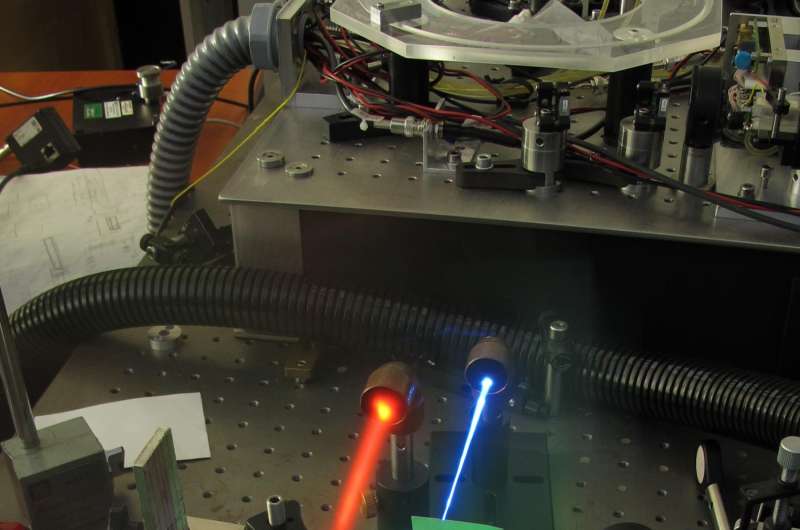Device generates UV spectrum laser pulses at record-breaking efficiency

A group of researchers from the Faculty of Physics at the University of Warsaw has just published the a report on their development of a miniature tripler device for generating femtosecond laser pulses in the UV spectrum. The device has three times higher efficiency than previously used setups, and fits on a finger tip, thanks to a unique software package developed in Warsaw during the design stage.
With new technologies, lasers cover a growing spectrum, but some wavelengths are still not easily accessible. This includes the ultraviolet (UV) band around 300 nm, especially if short pulse durations and/or high intensities are needed. Often, UV pulses are generated via nonlinear processes such as second harmonic generation or sum frequency generation, in which new photons with higher energy and a new color are formed by summing up the energy of the fundamental pulse photons. The efficiency of these processes is low, however.
For many years, analytical light propagation models or simple numerical simulations were used to design frequency converters. They allowed scientists to tweak device parameters, typically one at a time. This approach resulted in the stagnation of conversion efficiencies from un-amplified infrared femtosecond lasers to the UV third harmonic at around 10 percent.
"It was like coming to the lab, tweaking one knob here, one knob there, while looking at the UV output power and trying to maximize it. And 10 percent is as good as one can get with this approach," says Michal Nejbauer, from the team of researchers based at the Faculty of Physics of the University of Warsaw, Poland.
But increasing computational power combined with clever programming tricks allowed for the global optimization of the frequency conversion process from infrared to UV for the first time.
"Our newly developed, open-source simulation package, called Hussar, allows even an inexperienced user to build a complex, three-dimensional, accurate simulations of multiple pulse propagation and interaction using simple blocks: input pulse parameters, material properties of the media and the processes involved," explains Tomasz Kardas, who developed the software. "Once we define the input pulse parameters, such as energy, duration and spatial beam profile, we essentially start searching for the best design over a large space of parameters: the nonlinear crystal thicknesses, the beam size, the beam waist position, etc. And, to our surprise, once we found these optimum values, built the device and measured its performance, the output UV pulses were exactly as simulated. This kind of quantitative agreement between what one gets on the screen and then measures in the lab is rather uncommon in nonlinear optics."
But increasing the tripling process efficiency by a factor of three, to above 30 percent, was just the first step. The researchers also aimed at miniaturization. Rather than using multiple components mounted on the laboratory table, their third harmonic generator (tripler) is just a tiny block of crystals stacked together.
"In fact, the one-inch metal holder that keeps all the elements together is the biggest part of the whole setup," explains Pawel Wnuk, who took a leading role in the device characterization experiments. As a result, the tripler prototype has the overall volume around 1000 times smaller than the traditional designs.
More information: Tomasz M. Kardaś et al, Full 3D modelling of pulse propagation enables efficient nonlinear frequency conversion with low energy laser pulses in a single-element tripler, Scientific Reports (2017). DOI: 10.1038/srep42889
Journal information: Scientific Reports
Provided by University of Warsaw




















